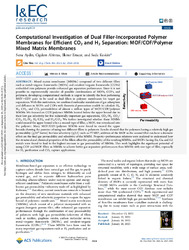Computational investigation of dual filler-incorporated polymer membranes for efficient CO2 and H2 separation: MOF/COF/Polymer mixed matrix membranes
| dc.contributor.author | Aydın, S. | |
| dc.contributor.author | Altintas, C. | |
| dc.contributor.author | Fındıkçı, İlknur Eruçar | |
| dc.contributor.author | Keskin, S. | |
| dc.date.accessioned | 2023-09-20T06:52:04Z | |
| dc.date.available | 2023-09-20T06:52:04Z | |
| dc.date.issued | 2023-01-26 | |
| dc.identifier.issn | 0888-5885 | en_US |
| dc.identifier.uri | http://hdl.handle.net/10679/8885 | |
| dc.identifier.uri | https://pubs.acs.org/doi/10.1021/acs.iecr.2c04500 | |
| dc.description.abstract | Mixed matrix membranes (MMMs) composed of two different fillers such as metal-organic frameworks (MOFs) and covalent-organic frameworks (COFs) embedded into polymers provide enhanced gas separation performance. Since it is not possible to experimentally consider all possible combinations of MOFs, COFs, and polymers, developing computational methods is urgent to identify the best performing MOF-COF pairs to be used as dual fillers in polymer membranes for target gas separations. With this motivation, we combined molecular simulations of gas adsorption and diffusion in MOFs and COFs with theoretical permeation models to calculate H2, N2, CH4, and CO2 permeabilities of almost a million types of MOF/COF/polymer MMMs. We focused on COF/polymer MMMs located below the upper bound due to their low gas selectivity for five industrially important gas separations, CO2/N2, CO2/CH4, H2/N2, H2/CH4, and H2/CO2. We further investigated whether these MMMs could exceed the upper bound when a second type of filler, a MOF, was introduced into the polymer. Many MOF/COF/polymer MMMs were found to exceed the upper bounds showing the promise of using two different fillers in polymers. Results showed that for polymers having a relatively high gas permeability (≥104 barrer) but low selectivity (≤2.5) such as PTMSP, addition of the MOF as the second filler can have a dramatic effect on the final gas permeability and selectivity of the MMM. Property-performance relations were analyzed to understand how the structural and chemical properties of the fillers affect the permeability of the resulting MMMs, and MOFs having Zn, Cu, and Cd metals were found to lead to the highest increase in gas permeability of MMMs. This work highlights the significant potential of using COF and MOF fillers in MMMs to achieve better gas separation performances than MMMs with one type of filler, especially for H2 purification and CO2 capture applications. | en_US |
| dc.description.sponsorship | European Union’s Horizon 2020 | |
| dc.language.iso | eng | en_US |
| dc.publisher | American Chemical Society | en_US |
| dc.relation.ispartof | Industrial and Engineering Chemistry Research | |
| dc.rights | Attribution 4.0 International | * |
| dc.rights | openAccess | |
| dc.rights.uri | http://creativecommons.org/licenses/by/4.0/ | * |
| dc.title | Computational investigation of dual filler-incorporated polymer membranes for efficient CO2 and H2 separation: MOF/COF/Polymer mixed matrix membranes | en_US |
| dc.type | Article | en_US |
| dc.description.version | Publisher version | en_US |
| dc.peerreviewed | yes | en_US |
| dc.publicationstatus | Published | en_US |
| dc.contributor.department | Özyeğin University | |
| dc.contributor.authorID | (ORCID 0000-0002-6059-6067 & YÖK ID 260094) Eruçar, İlknur | |
| dc.contributor.ozuauthor | Fındıkçı, İlknur Eruçar | |
| dc.identifier.volume | 62 | en_US |
| dc.identifier.issue | 6 | en_US |
| dc.identifier.startpage | 2924 | en_US |
| dc.identifier.endpage | 2936 | en_US |
| dc.identifier.wos | WOS:000937193000001 | |
| dc.identifier.doi | 10.1021/acs.iecr.2c04500 | en_US |
| dc.identifier.scopus | SCOPUS:2-s2.0-85147158250 | |
| dc.relation.publicationcategory | Article - International Refereed Journal - Institutional Academic Staff |
Files in this item
This item appears in the following Collection(s)
Share this page




